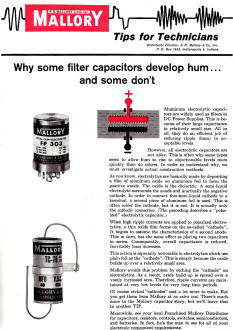Mallory Filter Capacitors - Tips for Technicians
|
|
Here is something you might not have known about electrolytic capacitors. I'm guessing the issue has been mitigated in modern capacitors, but in 1962 when this "Tips for Technicians" infomercial was published in Radio−Electronics magazine, an electrochemical mechanism could occur in electrolytic capacitors which reduced the effective capacitance by creating the equivalent of two or more capacitors in series. Capacitors in series combine like resistors in parallel, reducing the equivalent value. It is impressive that the scientists / chemists / engineers at Mallory were able to figure out what was causing electrolytic capacitors to decrease in value over time. This is the kind of thing that might show up in a Mac's Service Shop episode. Read on to find out what was going on. Mallory Filter Capacitors - Tips for TechniciansTips for Technicians Distributor Division, P. R. Mallory & Co. Inc. P. O. Box 1558, Indianapolis 6, Indiana Why some filter capacitors develop hum ... and some don't Aluminum electrolytic capacitors are widely used as filters in DC Power Supplies. This is because of their large capacitance in relatively small size. All in all, they do an efficient job of reducing ripple (hum) to acceptable levels. However, all electrolytic capacitors are not alike. This is often why some types seem to allow hum to rise to objectionable levels more quickly than do others. In order to understand why, we must investigate actual construction methods. As you know, electrolytics are basically made by depositing a film of aluminum oxide on aluminum foil to form the positive anode. The oxide is the dielectric. A semi-liquid electrolyte surrounds the anode and is actually the negative cathode. In order to connect this semi-liquid cathode to a terminal, a second piece of aluminum foil is used. This is often called the cathode, but it is not. It is actually only the cathodic connection. (The preceding describes a "polarized" electrolytic capacitor.) When high ripple currents are applied to polarized electrolytics, a thin oxide film forms on the so-called "cathode". It begins to assume the characteristics of a second anode. This in turn, has the same effect as placing two capacitors in series. Consequently, overall capacitance is reduced. Inevitably hum increases. This action is especially noticeable in electrolytics which use plain foil as the "cathode". This is simply because the oxide builds up over a relatively small area. Mallory avoids this problem by etching the "cathode" on electrolytics. As a result, oxide build-up is spread over a vastly increased area. Therefore, ripple currents are maintained at very low levels for very long time periods. Of course etched "cathodes" cost a lot more to make. But you get them from Mallory at no extra cost. There's much more to the Mallory capacitor story, but we'll leave that to another TIP. Meanwhile, see your local Franchised Mallory Distributor for capacitors, resistors, controls, switches, semiconductors, and batteries. In fact, he's the man to see for all of your electronic component requirements.
Posted March 22, 2024 |
|

